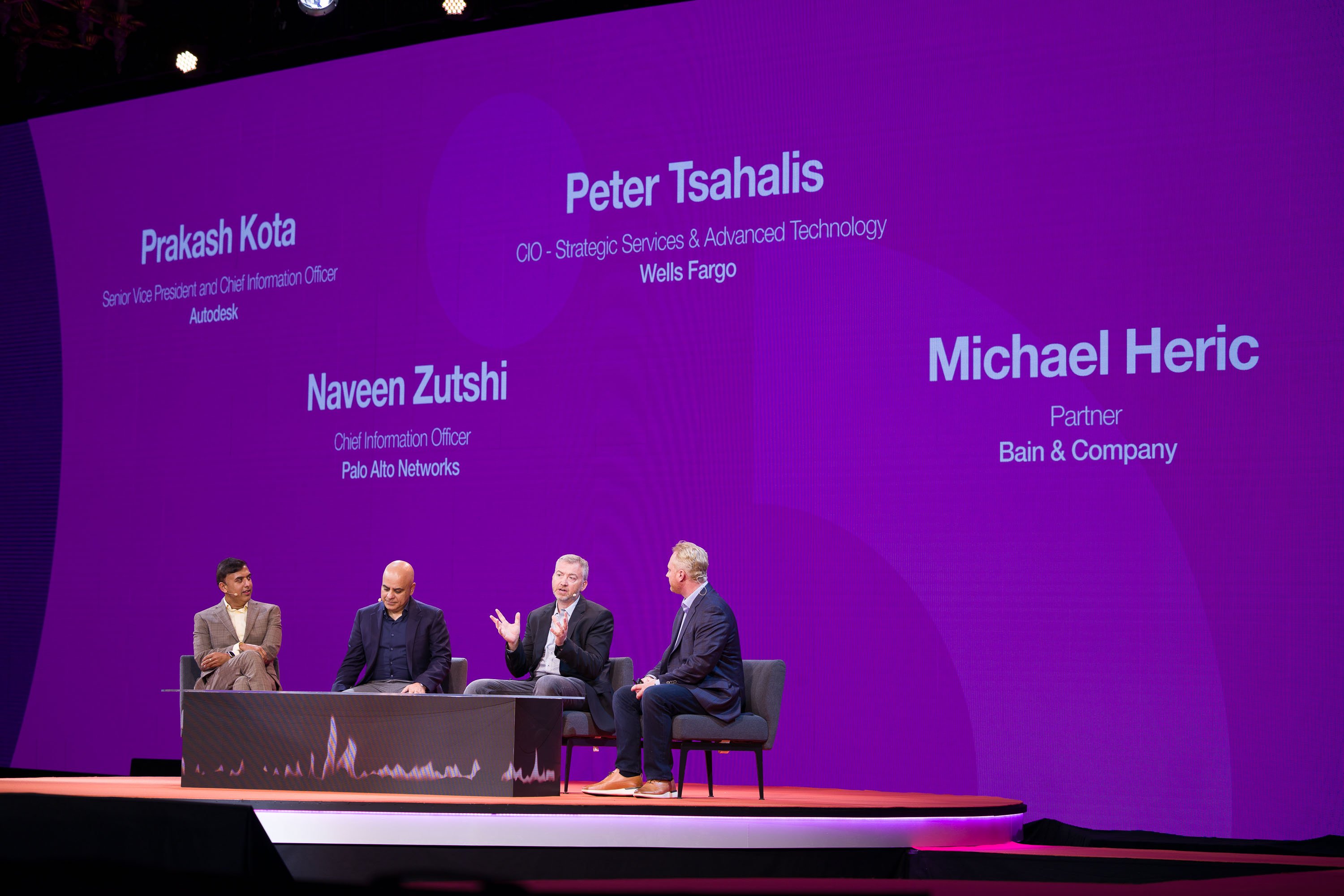The CIO's Perspective on Automation
Share at:

At FORWARD IV last month, three chief information officers (CIOs) who are leading automation practitioners joined Michael Heric of Bain Research Company to discuss all things automation-related. Prakash Kota of Autodesk, Naveen Zutshi of Palo Alto Networks, and Peter Tsahalis of Wells Fargo spoke with Heric about:
How automation enables their business strategy
How to drive a successful automation program
How to work with a CIO on automation initiatives
CIOs are deeply involved in both business and IT strategies. That makes them perfect candidates to discuss how automation can transform the way IT and business leaders work together. CIOs are also very busy people, so the FORWARD IV session was a rare opportunity for a frank conversation with leaders who are on the front lines of this new era of business.
Here’s a quick summary of the topics covered.
Robotic process automation (RPA)— value driver or Band-Aid?
Zutshi shared that his initial sense was that robotic process automation (RPA) was simply a rules-based engine. As Palo Alto Networks went through a period of rapid growth, its processes changed dramatically—along with its appreciation for the power of RPA. UiPath helped the company transform core processes in operations, and now it’s targeting use cases in sales ops, accounting, and legal.
Digitization is about removing friction for users. That’s where automation comes into play. We’re leveraging automation behind the scenes to give good experiences to users.
Naveen Zutshi, CIO, Palo Alto Networks
Kota noted how RPA created significant added value for Autodesk. The idea of automation is exciting. And as a software company, the team’s first instinct was to experiment with RPA to see what was possible. That’s why Kota emphasized the need to clearly define how the company would use RPA. He believes that it’s essential to have a governance structure for using RPA. Autodesk found that RPA is ideal for use cases with complex processes involving multiple applications and human intervention.
How do you build a successful automation program?
According to Tsahalis, it all starts with understanding bottlenecks. It’s easy to get excited about a large business portfolio that’s ripe for automation—with the potential to save tens of millions of dollars. But it can be equally disappointing to find out that it takes time to assemble the right team.
“It’s not enough to have an army of citizen developers,” said Tsahalis. “It’s not enough to have a center of excellence (CoE). You need those things. They’re critical. But at the end of the day, automation tools like RPA simplify, modify, and correct workflows. And you need those subject matter experts (SMEs) to be engaged.”
Tsahalis also explained that those SMEs tend to be the busiest people in the organization, so their time and attention are in short supply. You need to be patient and intelligent about how to use the limited bandwidth of process expertise. Process SMEs play the critical role of knowledge masters that guide the automation team.
But not all industries operate on the same timeline with the same priorities.
As Zutshi put it, “For us, the currency is speed. If we’re not going fast enough, a start up in security will disrupt us.”
It’s incumbent on business process leaders to share their strategy and challenges with IT upfront. IT is accountable for working with business experts to automate at the speed necessary to stay competitive. He recommended creating a steering committee made up of business leaders and IT professionals. The committee’s job is to prioritize the backlog of work and identify use cases for automation. The CoE can then deliver on those directives.
As our business transformation happened, IT had to transform and enable the business. For that to happen, we had a lot of work to do with automation.
Prakash Kota, SVP and CIO, Autodesk
For Autodesk, a successful program meant a shift in mindset. Kota discussed how the traditional approach for most IT groups was to focus on doing all the technical work for business divisions. But when the pace of business accelerates, IT can become the bottleneck that slows down innovation.
“The role that IT needs to play is to be an enabling function,” Kota said. “You need to create governance and guardrails to enable different functional groups to be self-sufficient. IT doesn’t need to build everything. You can be involved in decision making and solutioning.”

What have you learned in your automation journey?
As in so many businesses, COVID meant a lot of immediate and disruptive change for Wells Fargo. Almost overnight, the company had to develop processes to support federally driven programs for United States (U.S.) Small Business Administration (SBA) and Paycheck Protection Program (PPP) loans. As Tsahalis explained, it usually takes time to spin up the machinery to manage new programs. But a speedy response was a top priority. If Wells Fargo was slow to react, its business customers couldn’t apply for a loan as quickly, which was bad for customers and for Wells Fargo. So Wells Fargo put the power of automation to work.
Our customers are looking for different ways to interact with us. Digitizing experiences and enabling workflows for customers have driven a whole evolution of technology for us.
Peter Tsahalis, EVP, CIO, Strategic Services and Advanced Technology, Wells Fargo
The Wells Fargo CoE created long, connected automations to make it easier for agents to walkthrough the loans process faster. It also developed an end-to-end auto-approval experience that helped more than 25% of applications get processed without human intervention.
“You have to broaden your horizons when you think about an automation toolset,” Tsahalis advised. “It’s not just about a bot automating three sub-par systems so fewer people have to use them. Automation can be used for rapid response. But they can also be used as risk and control tools when you need to bring consistency to a workflow.”
When Autodesk started with RPA, the IT team wanted to automate everything. Kota spoke of how his team was eager to jump into automating a new process before the process was complete. “The key learning that we had is that we need to make sure we slow down. You need to slow down to go fast. You need to spend more time on having the right process outlined and having clear process owners for that area before you focus on automating.”
Zutshi discussed how the pandemic turned assumptions about workplace productivity upside down.
“People are more productive, just as hard working, and just as committed as engaged in a remote setting,” observed Zutshi. “And what you see now in a hybrid workforce will be there permanently.”
Zutshi’s team built a new tool stack from the ground up to provide experiential learning to support a hybrid work model. It also instituted a flex work program with other companies in the San Francisco area to help employees choose benefits and complete other tasks.
The hybrid work model is here to stay, and that means more challenges in cybersecurity, as well as a new role for IT and automation. “We continue to learn. How we engage employees in a hybrid work setting is something we’ll continue to work on,” said Zutshi.
Recommended read: Why The Hybrid Work Model Needs A New Tech Stack
What’s the right governance model for an automation program?
Tsahalis believes that it takes a village.
A CIO understands how technology works and can identify where the business needs to automate and modernize. IT can also guide automation governance to regulate how and when to use bots and what their lifespan should be. But the close collaboration of IT and business process experts is essential. “A lot of the things we’re trying to automate are legacy business flows, so you need your business partners in the game in a significant way,” said Tsahalis.
Recommended read: How to Achieve Business-IT Alignment for Automation Success
Business leaders should participate in steering committees dedicated to finding ways to free up time for process SMEs. It’s critical for stakeholders to understand the scope of an automation project. Deploying bots is relatively easy. The harder part is building a consensus of stakeholders and educating them on what automation can achieve.
Kota explained that the non-functional aspects of automation are just as critical to success as building bots. Organizations need a plan for maintaining, sustaining, and retiring the automations they create. IT is always adding new applications and tools, but it doesn’t give much thought to retiring existing bots that may have served their purpose. “It’s not just about building it. It’s about maintaining it. And at some point you need a plan for retiring it,” Kota emphasized.
For Zutshi, it was the wrong question to be asking. “All of us here believe automation should occur early in the journey rather than later in the journey. We believe there’s a tremendous amount of work to be done to achieve automation everywhere,” said Zutshi. “We’re in the early stages of that mission. You have a lot of target-rich opportunities to solve. But it’s less about who owns it and more about how you’re solving those problems. Are you solving them at scale and with the right processes?”
He emphasized that monitoring automation performance, maintenance, and change management are collective responsibilities that should be shared equally by IT and business process owners.
Parting advice for partnering more effectively with IT
Automate responsibly. That’s the message from Tsahalis.
“Each time you automate a workflow, you have to understand the outcome very clearly. And that outcome has to be agreed on by a business leader, an IT leader, and sometimes risk and control leaders.”
He also highlighted the need to be honest as to whether you’re trying to extend the life of a system or process that should be retired instead.
Kota’s parting advice: “Don’t automate if the process is not clearly defined and you don’t have a proper process owner identified.” Don’t just jump in and automate for the sake of automation.
Finally, Zutshi recommended, “Bring in IT early on in the strategic automation journey.”
The sooner you do, the quicker you can resolve issues that could snowball into roadblocks further along in the process.
Many thanks to Tsahalis, Zutshi, and Kota for sharing their insights at this one-of-a-kind session. You can register to watch the replay of the session or FORWARD attendees can find session recordings right in the UiPath Events app.
And if you’d like a recap of the top takeaways from last month’s event in Las Vegas, sign up for UiPath FORWARD IV ‘The Best Bits’ to get exclusive content from the conference.

Editorial Director, Corporate Blog, UiPath
Get articles from automation experts in your inbox
SubscribeGet articles from automation experts in your inbox
Sign up today and we'll email you the newest articles every week.
Thank you for subscribing!
Thank you for subscribing! Each week, we'll send the best automation blog posts straight to your inbox.



